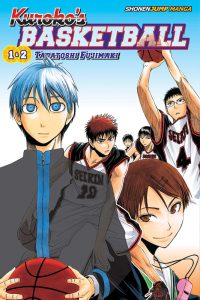By Tadatoshi Fujimaki | Published by VIZ Media

Tetsuya Kuroko is a plain and unremarkable guy with a talent for going unnoticed. On the basketball court, this means that despite his unimpressive physique and lackluster shooting ability, he is extremely valuable because he can get the ball to the right person without giving the opposing team the chance to react. In middle school, he was part of a legendary team that included the five members of the “Miracle Generation,” stellar players who all happened to be born in the same year. Although each of them has now gone on to different elite schools, Kuroko disliked the sole emphasis on winning and so chose to attend newly established Seirin, where he could experience teamwork with people who simply loved basketball. He forms a partnership with his fellow talented first-year, Taiga Kagami, to defeat the Miracle Generation players and make Kagami the best in Japan.
I’ve been reading a lot of sports manga lately, which is great, but also gives me a variety of titles to compare Kuroko’s Basketball to. The emphasis on someone who’s very skilled at helping others score is reminiscent of Haikyu!! and the character of Kageyama, and in both cases I appreciate a potentially unheralded position/skill getting its due. And, of course, how many sports manga are there that feature a pair of special first years? Quite a few, I’d reckon, though Kuroko and Kagami avoid the rivals-butting-heads trope. And how many launch quickly into inter-high qualifying matches? Quite a few.
Still, there are things each series does differently, and in Kuroko, at least so far, I mostly see what has been omitted. Instead of starting off with some practice sessions to introduce the team and familiarize readers with their personalities and specialties, we dive right into a practice game against a team containing one of the Miracle Generation. It’s not until the second volume that the other players on the team even get names. And then, once the qualifiers begin—from which only three teams of 300 will continue on to represent Tokyo at Nationals—three of Seirin’s first four matches are skipped and merely summarized in a panel or two. It’s kind of disappointing.
We do see some evolution of skills, particularly in how Kuroko and Kagami are able to work together, but when they receive a special training regimen in preparation for the inter-high, we only get a brief glimpse of what Kagami learned and nothing at all about what Kuroko was doing. Perhaps that’ll come into play in a future volume.
What appeals to me most so far is the attitude of the players, particularly Kagami, who loves the sport and loves a good challenge, and isn’t afraid to go up against someone even if he might lose. Too, I love the seed of doubt planted in Kuroko’s mind by an opponent—what happens when Kagami achieves his full potential and realizes how great he really is? Will he drift away from his teammates?
Ultimately, I did enjoy this introduction to the series and look forward to the next volume.
Kuroko’s Basketball is complete in 30 volumes. The next 2-in-1 edition from VIZ contains volumes three and four and will be released on October 4th, with further installments proceeding on a bimonthly release schedule.
Review copy provided by the publisher.




Recent Comments